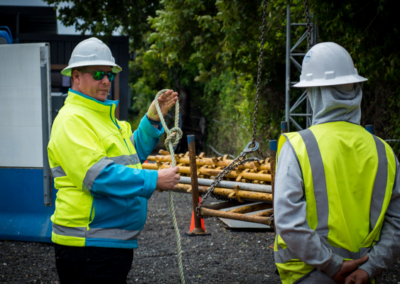Dogging and Rigging – A Beginner’s Guide
Employment & Careers | 2 Minute Read
Written by Jimmi Nolan
Join our mailing list for 10% off your next course Subscribe

If you’re looking to get into the construction industry, you may have heard the terms “dogging” and “rigging” being thrown around. But what do they mean?
What’s the difference between a dogger and a rigger? And what levels of rigging are there? In this blog post, we’ll explain all that and more, so you can make an informed decision about your career in construction.
What is Dogging?
Let’s start with dogging. Doggers are responsible for determining the weight and applying suitable slinging techniques to lift a load and inspecting lifting gear to ensure it’s fit and safe to use . They are also responsible for communicating with the crane operator and directing them when moving a load. This is of particular importance when the load is not in their line of site.
With a ‘Licence to Perform Dogging’ (DG), a dogger ultimately has a duty of care to themselves, civilians and other workers’ safety on/ near a site operating in the vicinity of cranes. Doggers need to identify hazards and implement control measures to reduce risk of harm, injury and damage, as well as be able to read plans and diagrams to determine how best to lift objects safely and efficiently.
Dogmen also need to be good communicators so they can guide operators in high risk situations when moving heavy loads or awkward objects. Typical objects and materials they are licenced to lift include steel plates, scaffolding, steel pipe stillage, brick cages and man/work boxes. Whether that be unloading materials with a vehicle mounted crane from a truck or around a work site with a mobile or tower crane.
For more information about how to become a certified and successful dogman and how to find work, check out our ‘How to Become a Dogman’ blog here.
What is rigging?
Riggers take care of mechanical load shifting equipment like cranes or hoists that move, place or secure a load. Using plant, equipment or members of a building or structures, riggers ensure the stability of those members. Riggers are also involved in the setting up or dismantling of cranes or hoists.
WATCH: some of the practical tasks required to obtain a Basic Rigging Licence
There are three levels of rigging: Basic, Intermediate and Advanced
Basic Rigging (RB)
With a ‘Licence to Perform Rigging Basic Level’ (RB), this allows the licence holder to erect and dismantle steel structures, hoists, safety nets and static lines, cantilevered crane loading platforms as well as placement of precast concrete panels and perimeter safety screens.
To be able to do a course to obtain a Basic Rigging Licence (aka Basic Riggers Ticket), you must have been deemed competent in the ‘Licence to Perform Dogging’ unit first.
An Intermediate Rigging Licence (RI) allows you to rig and conduct dual lifts often required for erecting cranes
Intermediate Rigging (RI)
Once you have a Basic Rigging Licence (RB) you can move onto the intermediate rigging level.
Intermediate rigging involves dual crane lifts, as well as rigging of cranes, conveyors, dredges and excavators. It also involves rigging of tilt slabs and demolition work.
Advanced Rigging (RA)
Congrats – now you have an Intermediate Rigging Licence (aka an Intermediate Riggers Ticket)! Time to join the rigging elite:
Advanced rigging incorporates erecting gin poles and shear legs, flying foxes and cable ways along with hung scaffolds. Ever wondered who rigs up swing stages that go over the side of a building for cleaning and maintenance purposes? An advanced rigger of course!
Doggers and Riggers Stick Together
You can see that there are clear differences between what a dogger or a rigger is licenced to do, but ultimately along with crane operators are always working closely together ensuring efficiency and safety on work sites. And remember, each course has a prerequisite of the level below before moving onto the next: Dogging –> Basic Rigging –> Intermediate Rigging –> Advanced Rigging.
Whether you’re an experienced labourer looking for a change in your career or someone considering entering the construction industry for the first time, dogging and rigging can be an excellent option! Understanding the difference between these two roles —as well as different levels of rigging—is so important and should only be undertaken by those competent in either.
Hopefully this blog post has given you some insight into what dogging and rigging involves so that you can make an informed decision about whether it’s right for you! Good luck!
WE OFFER WEEKLY DOGGING COURSES AND ALL LEVELS OF RIGGING
So what are you waiting for? Enrol in a course today!
ADDITIONAL DOGGING & RIGGING Content
Tower Crane Dream: How a Bricklayer Became a Dogman
Sometimes you meet that special student, who you can immediately sense as a trainer that they are not only here to learn; they are metaphorically wearing their career goals on their sleeve. Read about Rhea’s inspiring story here.
6 Reasons you Need a Dogging Ticket
If you work in construction in Australia, chances are you’ve heard of a ‘Dogging ticket’. But what exactly is it? Why should you get one? How much can a dogger earn?
How to become a Dogman
Ever thought about what it takes and what you need to do to become a certified dogman? We share some pro tips about how to be a successful Dogman, get hired and rehired.
Basic Riggers In Action
Check out a time lapse of some previous ‘Licence to Perform Rigging Basic Level’ students performing their practical tasks.
Contact Us
Contact us any time using the details below. Alternatively, leave us a message using the enquiry form we will get back to you the following business day at the latest.
Phone: 07 3807 6061
Email: admin@onthejobtraining.edu.au
Address: 79 Christensen Road, Stapylton QLD 4207
Usual Business Hours: Mon - Fri 6.30AM - 5:00PM












